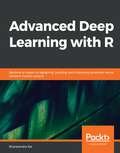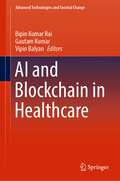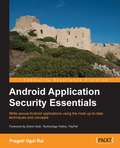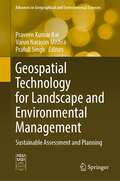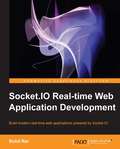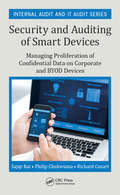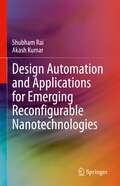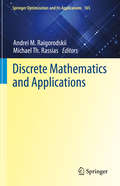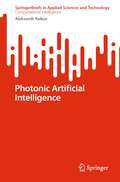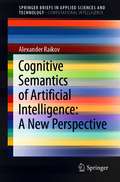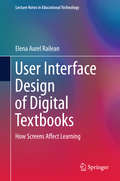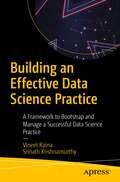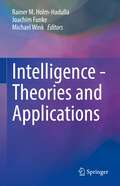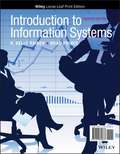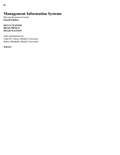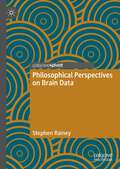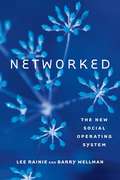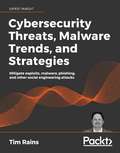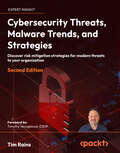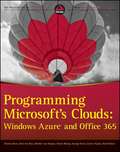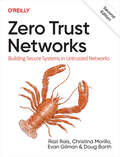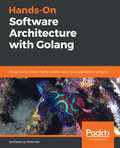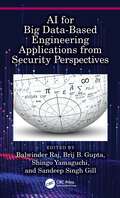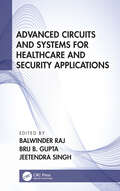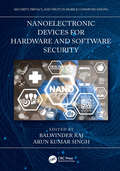- Table View
- List View
Advanced Deep Learning with R: Become an expert at designing, building, and improving advanced neural network models using R
by Bharatendra RaiThis book is for data scientists, machine learning practitioners, deep learning researchers and AI enthusiasts who want to extend their skills and knowledge to implement deep learning techniques and algorithms using the power of R. With this book, you will learn to build advanced neural networks using extensive libraries from R ecosystem. Strong understanding of machine learning and working knowledge of R programming language is expected.
AI and Blockchain in Healthcare (Advanced Technologies and Societal Change)
by Bipin Kumar Rai Gautam Kumar Vipin BalyanThis book presents state-of-the-art blockchain and AI advances in health care. Healthcare service is increasingly creating the scope for blockchain and AI applications to enter the biomedical and healthcare world. Today, blockchain, AI, ML, and deep learning are affecting every domain. Through its cutting-edge applications, AI and ML are helping transform the healthcare industry for the better. Blockchain is a decentralization communication platform that has the potential to decentralize the way we store data and manage information. Blockchain technology has potential to reduce the role of middleman, one of the most important regulatory actors in our society. Transactions are simultaneously secure and trustworthy due to the use of cryptographic principles. In recent years, blockchain technology has become very trendy and has penetrated different domains, mostly due to the popularity of cryptocurrencies. One field where blockchain technology has tremendous potential is health care, due to the need for a more patient-centric approach in healthcare systems to connect disparate systems and to increase the accuracy of electronic healthcare records (EHRs).
Android Application Security Essentials
by Pragati Ogal RaiAndroid Application Security Essentials is packed with examples, screenshots, illustrations, and real world use cases to secure your apps the right way.If you are looking for guidance and detailed instructions on how to secure app data, then this book is for you. Developers, architects, managers, and technologists who wish to enhance their knowledge of Android security will find this book interesting. Some prior knowledge of development on the Android stack is desirable but not required.
Geospatial Technology for Landscape and Environmental Management: Sustainable Assessment and Planning (Advances in Geographical and Environmental Sciences)
by Praveen Kumar Rai Varun Narayan Mishra Prafull SinghGeospatial technology is a combination of state-of-the-art remote sensing and technology for geographic information systems (GIS) and global navigation satellite systems (GNSS) for the mapping and monitoring of landscapes and environment. The main thrust of using geospatial technology is to understand the causes, mechanisms, and consequences of spatial heterogeneity, while its ultimate objective is to provide a scientific basis for developing and maintaining ecologically, economically, and socially sustainable landscapes. This book presents new research on the interdisciplinary applications of geospatial technology for identification, assessment, monitoring, and modelling issues related to landscape, natural resources, and environmental management. The book specifically focuses on the creation, collection, storage, processing, modelling, interpretation, display, and dissemination of spatio-temporal data, which help to resolve environmental management issues including ecosystem change, resource utilization, land use management, and environmental pollution. The positive environmental impacts of information technology advancements with regard to global environmental and climate change are also discussed. The book addresses the interests of a wide spectrum of readers who have a common interest in geospatial science, geology, water resource management, database management, planning and policy making, and resource management.
Socket.io Real-time Web Application Development
by Rohit RaiWritten in an engaging, easy-to-follow style, "Socket.io Real-time Web Application Development" is a practical guide for developing real-time web applications with Node.js and socket.io.This book is aimed at developers who want to start developing highly interactive and real-time web applications like chat systems or online multiplayer games, or want to introduce real-time updates or server push mechanisms in their existing applications. Knowledge of developing in JavaScript and web applications in general is expected. Though there is a chapter on introducing Node.js, prior knowledge of Node.js will be a plus.
Security and Auditing of Smart Devices: Managing Proliferation of Confidential Data on Corporate and BYOD Devices (Security, Audit and Leadership Series)
by Sajay Rai Philip Chukwuma Richard CozartMost organizations have been caught off-guard with the proliferation of smart devices. The IT organization was comfortable supporting the Blackberry due to its ease of implementation and maintenance. But the use of Android and iOS smart devices have created a maintenance nightmare not only for the IT organization but for the IT auditors as well. This book will serve as a guide to IT and Audit professionals on how to manage, secure and audit smart device. It provides guidance on the handling of corporate devices and the Bring Your Own Devices (BYOD) smart devices.
Design Automation and Applications for Emerging Reconfigurable Nanotechnologies
by Shubham Rai Akash KumarThis book is a single-source solution for anyone who is interested in exploring emerging reconfigurable nanotechnology at the circuit level. It lays down a solid foundation for circuits based on this technology having considered both manual as well as automated design flows. The authors discuss the entire design flow, consisting of both logic and physical synthesis for reconfigurable nanotechnology-based circuits. The authors describe how transistor reconfigurable properties can be exploited at the logic level to have a more efficient circuit design flow, as compared to conventional design flows suited for CMOS. Further, the book provides insights into hardware security features that can be intrinsically developed using the runtime reconfigurable features of this nanotechnology.
Discrete Mathematics and Applications (Springer Optimization and Its Applications #165)
by Andrei M. Raigorodskii Michael Th. RassiasAdvances in discrete mathematics are presented in this book with applications in theoretical mathematics and interdisciplinary research. Each chapter presents new methods and techniques by leading experts. Unifying interdisciplinary applications, problems, and approaches of discrete mathematics, this book connects topics in graph theory, combinatorics, number theory, cryptography, dynamical systems, finance, optimization, and game theory. Graduate students and researchers in optimization, mathematics, computer science, economics, and physics will find the wide range of interdisciplinary topics, methods, and applications covered in this book engaging and useful.
Photonic Artificial Intelligence (SpringerBriefs in Applied Sciences and Technology)
by Aleksandr RaikovThis book addresses an attempt to create Photonic Artificial Intelligence (PAI) system based on optical technologies, which process signals continuously. PAI could help to overcome digital computer limits and almost zero out the machine learning time and AI inference. It helps to consider feelings, the chaos of thoughts, cognitive activity, and the transcendental states of the human mind in AI systems. The book also discusses new problems such as synthesizing new photonic materials, creating optical control systems, and connecting PAI systems with outside digital computers and holographic memory. The book is aimed at a wide range of readers, including postgraduates and researchers, interested in advanced AI by creating its new paradigm, which can help to overcome traps of traditional AI development.
Cognitive Semantics of Artificial Intelligence: A New Perspective (SpringerBriefs in Applied Sciences and Technology)
by Alexander RaikovThis book addresses the issue of cognitive semantics’ aspects that cannot be represented by traditional digital and logical means. The problem of creating cognitive semantics can be resolved in an indirect way. The electromagnetic waves, quantum fields, beam of light, chaos control, relativistic theory, cosmic string recognition, category theory, group theory, and so on can be used for this aim. Since the term artificial intelligence (AI) appeared, various versions of logic have been created; many heuristics for neural networks deep learning have been made; new nature-like algorithms have been suggested. At the same time, the initial digital, logical, and neural network principles of representation of knowledge in AI systems have not changed a lot. The researches of these aspects of cognitive semantics of AI are based on the author's convergent methodology, which provides the necessary conditions for purposeful and sustainable convergence of decision-making.
User Interface Design of Digital Textbooks
by Elena Aurel RaileanThis book is a synthesis of the complex interdependencies between user interface design of digital screen and learning process. It is analyzed the impact of digital revolution on learning, phases of digital textbooks use and development; specific features of educational system & learning environment; psycho-pedagogical characteristics of XXI students; user interface design topology; user interface design features of digital textbooks in accordance with human thinking paradigms; critical thinking of user interfaces and content (linear, systems, global and metasystems design approach). One special chapter describes innovative organizational forms of learning with digital textbooks. Metasystems learning design of digital textbooks will be of particular interest to the readers because this is an innovative approach of learning design, which proved the experimental data of the instructional dynamic and flexible strategy. It proved the practical application of didactical model of digital textbooks for chemistry and mathematics. The main benefits for reader refers on understanding the applicability of metasystems learning design for digital textbook use and development, in particular for STEM education. It takes more than analysis to help readers overcome the impact of user interface design of digital textbook on learning outcomes.
Building an Effective Data Science Practice: A Framework to Bootstrap and Manage a Successful Data Science Practice
by Vineet Raina Srinath KrishnamurthyGain a deep understanding of data science and the thought process needed to solve problems in that field using the required techniques, technologies and skills that go into forming an interdisciplinary team. This book will enable you to set up an effective team of engineers, data scientists, analysts, and other stakeholders that can collaborate effectively on crucial aspects such as problem formulation, execution of experiments, and model performance evaluation.You’ll start by delving into the fundamentals of data science – classes of data science problems, data science techniques and their applications – and gradually build up to building a professional reference operating model for a data science function in an organization. This operating model covers the roles and skills required in a team, the techniques and technologies they use, and the best practices typically followed in executing data science projects.Building an Effective Data Science Practice provides a common base of reference knowledge and solutions, and addresses the kinds of challenges that arise to ensure your data science team is both productive and aligned with the business goals from the very start. Reinforced with real examples, this book allows you to confidently determine the strategic answers to effectively align your business goals with the operations of the data science practice. What You’ll Learn Transform business objectives into concrete problems that can be solved using data scienceEvaluate how problems and the specifics of a business drive the techniques and model evaluation guidelines used in a projectBuild and operate an effective interdisciplinary data science team within an organizationEvaluating the progress of the team towards the business RoIUnderstand the important regulatory aspects that are applicable to a data science practice Who This Book Is For Technology leaders, data scientists, and project managers
Intelligence - Theories and Applications
by Rainer M. Holm-Hadulla Joachim Funke Michael WinkIntelligence allows people to understand events and to shape their surrounding environment. This book delves deeper into the theories and applications of intelligence, showing it is a multifaceted concept —defined and explained differently by prestigious experts of various disciplines in their own research. The book provides interdisciplinary connections of intelligence as it relates to a variety of clearly outlined subject areas, and should lead to a deep understanding of the phenomenon as it pertains to practical applications in different domains. Contributors in this volume present results from evolutionary biology, mathematics, artificial intelligence, medicine, psychology, cultural studies, economy, political sciences and philosophy. Individual scientific models are integrated in an interdisciplinary concept of wisdom. This volume will help enhance the common understanding of intelligence for fellow researchers and scientists alike.
Introduction to Information Systems: Seventh Edition
by R. Kelly Rainer Casey G. CegielskiThe goal of Introduction to Information Systems is to teach undergraduate business majors how to use information technology to master their current or future jobs. Students develop a working understanding of information systems and information technology and learn how to apply concepts to successfully facilitate business processes. This product demonstrates that IT is a key component of any business, whether a student is majoring in Accounting, Finance, Marketing, Human Resources, or Production/Operations Management.
Management Information Systems: Moving Business Forward
by R. Kelly Rainer Brad Prince Hugh J. WatsonThe 4th Edition of Management Information Systems promotes active learning like no other text in the market. Each chapter is comprised of tightly coupled concepts and section-level student activities that transport your students from passively learning about IS to doing IS in a realistic context. The integration of Microsoft Excel and Access exercises at the end of every chapter enables students to practice their Microsoft application skills in the context of the chapter material.
Philosophical Perspectives on Brain Data
by Stephen RaineyWhere there is data there are questions of ownership, leaks, and worries about misuse. When what’s at stake is data on our brains, the stakes are high. This book brings together philosophical analysis and neuroscientific insights to develop an account of ‘brain data’: what it is, how it is used, and how we ought to take care of it. Emerging trends in neuroscience appear to make mental activity legible, through sophisticated processing of signals recorded from the brain. This can include Artificial Intelligence (AI), with algorithms classifying brain signals for further processing. These developments will have ramifications for concepts of the brain, the self, and the mind. They will also affect clinical practices like psychiatry, by modifying concepts of mental health and introducing AI-based diagnostic and treatment strategies. The issues arising are vastly complicated, little understood, but of high importance. Philosophical Perspectives on Brain Data clarifies complex intersections of philosophical and neuroscientific interest, presenting an account of brain data that is comprehensible. This account can be the basis for evaluating practices based on brain data. As such, the book aims to open a novel space for evaluating hitherto arcane areas of academic research in order to provide the necessary scope for understanding their real-world consequences. These consequences will include personal, socio-political, and public health dimensions. It is therefore vital that they are understood if their impacts upon aspects of everyday life can be evaluated adequately.
Networked
by Lee Rainie Barry WellmanDaily life is connected life, its rhythms driven by endless email pings and responses, the chimes and beeps of continually arriving text messages, tweets and retweets, Facebook updates, pictures and videos to post and discuss. Our perpetual connectedness gives us endless opportunities to be part of the give-and-take of networking. Some worry that this new environment makes us isolated and lonely. But in Networked, Lee Rainie and Barry Wellman show how the large, loosely knit social circles of networked individuals expand opportunities for learning, problem solving, decision making, and personal interaction. The new social operating system of "networked individualism" liberates us from the restrictions of tightly knit groups; it also requires us to develop networking skills and strategies, work on maintaining ties, and balance multiple overlapping networks. Rainie and Wellman outline the "triple revolution" that has brought on this transformation: the rise of social networking, the capacity of the Internet to empower individuals, and the always-on connectivity of mobile devices. Drawing on extensive evidence, they examine how the move to networked individualism has expanded personal relationships beyond households and neighborhoods; transformed work into less hierarchical, more team-driven enterprises; encouraged individuals to create and share content; and changed the way people obtain information. Rainie and Wellman guide us through the challenges and opportunities of living in the evolving world of networked individuals.
Cybersecurity Threats, Malware Trends, and Strategies: Mitigate exploits, malware, phishing, and other social engineering attacks
by Tim RainsAfter scrutinizing numerous cybersecurity strategies, Microsoft's former Global Chief Security Advisor provides unique insights on the evolution of the threat landscape and how enterprises can address modern cybersecurity challenges. Key Features Protect your organization from cybersecurity threats with field-tested strategies by the former most senior security advisor at Microsoft Discover the most common ways enterprises initially get compromised Measure the effectiveness of your organization's current cybersecurity program against cyber attacks Book Description Cybersecurity Threats, Malware Trends, and Strategies shares numerous insights about the threats that both public and private sector organizations face and the cybersecurity strategies that can mitigate them. The book provides an unprecedented long-term view of the global threat landscape by examining the twenty-year trend in vulnerability disclosures and exploitation, nearly a decade of regional differences in malware infections, the socio-economic factors that underpin them, and how global malware has evolved. This will give you further perspectives into malware protection for your organization. It also examines internet-based threats that CISOs should be aware of. The book will provide you with an evaluation of the various cybersecurity strategies that have ultimately failed over the past twenty years, along with one or two that have actually worked. It will help executives and security and compliance professionals understand how cloud computing is a game changer for them. By the end of this book, you will know how to measure the effectiveness of your organization's cybersecurity strategy and the efficacy of the vendors you employ to help you protect your organization and yourself. What you will learn Discover cybersecurity strategies and the ingredients critical to their success Improve vulnerability management by reducing risks and costs for your organization Learn how malware and other threats have evolved over the past decade Mitigate internet-based threats, phishing attacks, and malware distribution sites Weigh the pros and cons of popular cybersecurity strategies of the past two decades Implement and then measure the outcome of a cybersecurity strategy Learn how the cloud provides better security capabilities than on-premises IT environments Who this book is for This book is for senior management at commercial sector and public sector organizations, including Chief Information Security Officers (CISOs) and other senior managers of cybersecurity groups, Chief Information Officers (CIOs), Chief Technology Officers (CTOs) and senior IT managers who want to explore the entire spectrum of cybersecurity, from threat hunting and security risk management to malware analysis. Governance, risk, and compliance professionals will also benefit. Cybersecurity experts that pride themselves on their knowledge of the threat landscape will come to use this book as a reference.
Cybersecurity Threats, Malware Trends, and Strategies: Discover risk mitigation strategies for modern threats to your organization, 2nd Edition
by Tim Rains Timothy Youngblood CISSPImplement effective cybersecurity strategies to help you and your security team protect, detect, and respond to modern-day threatsPurchase of the print or Kindle book includes a free eBook in PDF format.Key FeaturesProtect your organization from cybersecurity threats with field-tested strategiesUnderstand threats such as exploits, malware, internet-based threats, and governmentsMeasure the effectiveness of your organization's current cybersecurity program against modern attackers' tacticsBook DescriptionTim Rains is Microsoft's former Global Chief Security Advisor and Amazon Web Services' former Global Security Leader for Worldwide Public Sector. He has spent the last two decades advising private and public sector organizations all over the world on cybersecurity strategies.Cybersecurity Threats, Malware Trends, and Strategies, Second Edition builds upon the success of the first edition that has helped so many aspiring CISOs, and cybersecurity professionals understand and develop effective data-driven cybersecurity strategies for their organizations. In this edition, you'll examine long-term trends in vulnerability disclosures and exploitation, regional differences in malware infections and the socio-economic factors that underpin them, and how ransomware evolved from an obscure threat to the most feared threat in cybersecurity. You'll also gain valuable insights into the roles that governments play in cybersecurity, including their role as threat actors, and how to mitigate government access to data. The book concludes with a deep dive into modern approaches to cybersecurity using the cloud.By the end of this book, you will have a better understanding of the threat landscape, how to recognize good Cyber Threat Intelligence, and how to measure the effectiveness of your organization's cybersecurity strategy.What you will learnDiscover enterprise cybersecurity strategies and the ingredients critical to their successImprove vulnerability management by reducing risks and costs for your organizationMitigate internet-based threats such as drive-by download attacks and malware distribution sitesLearn the roles that governments play in cybersecurity and how to mitigate government access to dataWeigh the pros and cons of popular cybersecurity strategies such as Zero Trust, the Intrusion Kill Chain, and othersImplement and then measure the outcome of a cybersecurity strategyDiscover how the cloud can provide better security and compliance capabilities than on-premises IT environmentsWho this book is forThis book is for anyone who is looking to implement or improve their organization's cybersecurity strategy. This includes Chief Information Security Officers (CISOs), Chief Security Officers (CSOs), compliance and audit professionals, security architects, and cybersecurity professionals. Basic knowledge of Information Technology (IT), software development principles, and cybersecurity concepts is assumed.
Programming Microsoft's Clouds
by Razi Bin Rais Thomas Rizzo Darrin Bishop George Durzi Zoiner Tejada David Mann Michiel Van OtegemA detailed look at a diverse set of Cloud topics, particularly Azure and Office 365More and more companies are realizing the power and potential of Cloud computing as a viable way to save energy and money. This valuable book offers an in-depth look at a wide range of Cloud topics unlike any other book on the market. Examining how Cloud services allows users to pay as they go for exactly what they use, this guide explains how companies can easily scale their Cloud use up and down to fit their business requirements. After an introduction to Cloud computing, you'll discover how to prepare your environment for the Cloud and learn all about Office 365 and Azure.Examines a diverse range of Cloud topics, with special emphasis placed on how Cloud computing can save businesses energy and moneyShows you how to prepare your environment for the CloudAddresses Office 365, including infrastructure services, SharePoint 2010 online, SharePoint online development, Exchange online development, and Lync online developmentDiscusses working with Azure, including setting it up, leveraging Blob storage, building Azure applications, programming, and debuggingOffers advice for deciding when to use Azure and when to use Office 365 and looks at hybrid solutions between Azure and Office 365Tap into the potential of Azure and Office 365 with this helpful resource.
Zero Trust Networks
by Razi Rais Christina Morillo Evan Gilman Doug BarthThis practical book provides a detailed explanation of the zero trust security model. Zero trust is a security paradigm shift that eliminates the concept of traditional perimeter-based security and requires you to "always assume breach" and "never trust but always verify." The updated edition offers more scenarios, real-world examples, and in-depth explanations of key concepts to help you fully comprehend the zero trust security architecture.Examine fundamental concepts of zero trust security model, including trust engine, policy engine, and context aware agentsUnderstand how this model embeds security within the system's operation, with guided scenarios at the end of each chapterMigrate from a perimeter-based network to a zero trust network in productionExplore case studies that provide insights into organizations' zero trust journeysLearn about the various zero trust architectures, standards, and frameworks developed by NIST, CISA, DoD, and others
Hands-On Software Architecture with Golang: Design And Architect Highly Scalable And Robust Applications Using Go
by Jyotiswarup RaiturkarThis book is for software developers, architects and CTOs looking to use Go in their software architecture. The book assumes general programming knowledge and architecture concepts. Familiarity with Go is not required and programming constructs are introduced with concepts.
AI for Big Data-Based Engineering Applications from Security Perspectives
by Balwinder RajArtificial intelligence (AI), machine learning, and advanced electronic circuits involve learning from every data input and using those inputs to generate new rules for future business analytics. AI and machine learning are now giving us new opportunities to use big data that we already had, as well as unleash a whole lot of new use cases with new data types. With the increasing use of AI dealing with highly sensitive information such as healthcare, adequate security measures are required to securely store and transmit this information. This book provides a broader coverage of the basic aspects of advanced circuits design and applications. AI for Big Data-Based Engineering Applications from Security Perspectives is an integrated source that aims at understanding the basic concepts associated with the security of advanced circuits. The content includes theoretical frameworks and recent empirical findings in the field to understand the associated principles, key challenges, and recent real-time applications of advanced circuits, AI, and big data security. It illustrates the notions, models, and terminologies that are widely used in the area of Very Large Scale Integration (VLSI) circuits, security, identifies the existing security issues in the field, and evaluates the underlying factors that influence system security. This work emphasizes the idea of understanding the motivation behind advanced circuit design to establish the AI interface and to mitigate security attacks in a better way for big data. This book also outlines exciting areas of future research where already existing methodologies can be implemented. This material is suitable for students, researchers, and professionals with research interest in AI for big data–based engineering applications, faculty members across universities, and software developers.
Advanced Circuits and Systems for Healthcare and Security Applications
by Balwinder Raj Brij B. Gupta Jeetendra SinghVLSI devices downscaling is a very significant part of the design to improve the performance of VLSI industry outcomes, which results in high speed and low power of operation of integrated devices. The increasing use of VLSI circuits dealing with highly sensitive information, such as healthcare information, means adequate security measures are required to be taken for the secure storage and transmission. Advanced Circuits and Systems for Healthcare and Security Applications provides broader coverage of the basic aspects of advanced circuits and security and introduces the corresponding principles. By the end of this book, you will be familiarized with the theoretical frameworks, technical methodologies, and empirical research findings in the field to protect your computers and information from adversaries. Advanced circuits and the comprehensive material of this book will keep you interested and involved throughout. The book is an integrated source which aims at understanding the basic concepts associated with the security of the advanced circuits and the cyber world as a first step towards achieving high-end protection from adversaries and hackers. The content includes theoretical frameworks and recent empirical findings in the field to understand the associated principles, key challenges and recent real-time applications of the advanced circuits and cybersecurity. It illustrates the notions, models, and terminologies that are widely used in the area of circuits and security, identifies the existing security issues in the field, and evaluates the underlying factors that influence the security of the systems. It emphasizes the idea of understanding the motivation of the attackers to establish adequate security measures and to mitigate security attacks in a better way. This book also outlines the exciting areas of future research where the already-existing methodologies can be implemented. Moreover, this book is suitable for students, researchers, and professionals in the who are looking forward to carry out research in the field of advanced circuits and systems for healthcare and security applications; faculty members across universities; and software developers.
Nanoelectronic Devices for Hardware and Software Security (Security, Privacy, and Trust in Mobile Communications)
by Balwinder Raj Arun Kumar SinghNanoelectronic Devices for Hardware and Software Security has comprehensive coverage of the principles, basic concepts, structure, modeling, practices, and circuit applications of nanoelectronics in hardware/software security. It also covers the future research directions in this domain. In this evolving era, nanotechnology is converting semiconductor devices dimensions from micron technology to nanotechnology. Nanoelectronics would be the key enabler for innovation in nanoscale devices, circuits, and systems. The motive for this research book is to provide relevant theoretical frameworks that include device physics, modeling, circuit design, and the latest developments in experimental fabrication in the field of nanotechnology for hardware/software security. There are numerous challenges in the development of models for nanoscale devices (e.g., FinFET, gate-all-around devices, TFET, etc.), short channel effects, fringing effects, high leakage current, and power dissipation, among others. This book will help to identify areas where there are challenges and apply nanodevice and circuit techniques to address hardware/software security issues.
